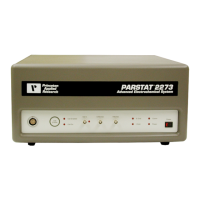7
Chapter 2 — SAFETY AND COMPONENT PLACEMENT
WARNING
If your instrument has been damaged, its protective grounding might not work.
Do not operate damaged equipment! Tag it to indicate to a potential user that it
is unsafe to operate.
NOTE
The standard system does not include an electrochemical cell. You must supply a
suitable cell and electrodes.
2.3. Defects and Abnormal Stresses
The PARSTAT 2273’s ground protection is likely to be impaired if, for example, the instrument:
Shows visible damage.
Fails to perform the intended measurement.
Has been subjected to prolonged storage under unfavorable conditions.
Has been subjected to severe transport stresses.
The instrument should not be used until its safety has been verified by qualified service personnel.
2.4. Component Placement
Before assembling the system, give some thought to component placement. You will of course
need convenient access to the computer keyboard and, if applicable, the printer. Depending on
the application, you might also need to connect and disconnect the cell leads regularly.
When you’re satisfied that the system is ready to install, connect the units according to the
instructions in Chapter 3.
2.4.1. Ventilation
The PARSTAT 2273 specifications apply at the nominal line voltage ±10% and at a temperature
of 25
(
C (77
(
F) unless otherwise noted. Ambient temperature must not exceed 50
(
C (122
(
F). See
Section 4.3 for more detailed environmental specifications.
To maintain a safe operating temperature, allow some free space (minimum 15 cm) behind the
PARSTAT 2273 for adequate air circulation.
2.4.2. Radio Frequency Interference
In a typical application, it is unlikely that the PARSTAT 2273 will act as a source of noticeable RF
interference. However, when operated near particularly sensitive equipment, interference from the
PARSTAT 2273 could be a problem. Following is a discussion of steps you can take to minimize
that interference.
Interference below about 10 MHz is most likely to be caused by RF currents flowing in the input
and output cables or in the power line cord.
If excessive noise pickup is present, check that other power sources or computer cables
(including monitor cables) are near the electrochemical cell or cell cable. If this does not eliminate
the problem, try decoupling the power line with an external filter. At frequencies below 100 kHz, an
external isolation transformer could be helpful.

